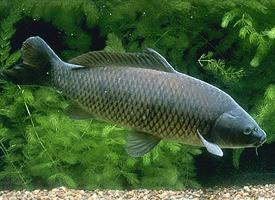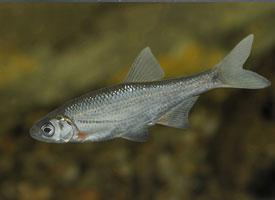
Poids et mesures
| Longueur | de 100 à 150 cm |
|---|---|
| Poids | de 15 à 50 kg |
Données biologiques
| Durée de vie | de 15 à 20 ans |
|---|
Description de l'animal
The Grass carp (Ctenopharyngodon idella), also known as the white amur, is a large, herbivorous freshwater fish species native to the rivers and lakes of eastern Asia, ranging from northern Vietnam to the Amur River on the Siberia-China border. This species has been introduced to other parts of the world, including the United States, primarily for aquatic weed control. The Grass carp is a member of the Cyprinidae family, which includes other carps and minnows.Adult Grass carps are substantial in size, often reaching lengths of up to 4 feet (1.2 meters) and can weigh up to 99 pounds (45 kilograms), though such sizes are less common. They have elongated, torpedo-shaped bodies, with broad, rounded heads and terminal mouths. Their scales are large and silvery, with dark edging, giving them a distinctive appearance. The dorsal fin is relatively short, with 7-10 soft rays, and they possess a long anal fin as well. One of the most distinguishing features of the Grass carp is its lack of barbels around the mouth, which differentiates it from many other carp species.
Grass carps are highly specialized feeders with a diet predominantly consisting of aquatic vegetation. They have a strong preference for certain types of plants, such as Hydrilla, Egeria, and Elodea, making them an effective tool for controlling invasive aquatic plant species in some contexts. However, their voracious appetite can also lead to the overconsumption of native vegetation, potentially disrupting local ecosystems and outcompeting native species for resources.
Reproduction in Grass carp occurs in large rivers, where the water flow is substantial. Spawning is stimulated by the rise in water level and temperature during the spring and early summer. Females can lay hundreds of thousands of eggs, which are fertilized externally by the males. The eggs then drift downstream, hatching as they go, with the larvae continuing to drift until they reach suitable nursery habitats. This reproductive strategy necessitates specific environmental conditions, and in many introduced environments, natural reproduction is not successful, requiring human intervention for population maintenance.
The introduction of Grass carp into non-native environments has been met with mixed outcomes. While they have proven effective for aquatic weed control in some contexts, there is also concern about their potential to cause ecological damage. In areas where they have been introduced, there are often strict regulations regarding their management, including the use of sterile (triploid) fish to prevent uncontrolled reproduction.
The Grass carp's significant impact on aquatic ecosystems, both positive and negative, highlights the complexity of using non-native species for environmental management. Their presence in non-native waters continues to be a subject of research and debate among scientists, conservationists, and fisheries managers, reflecting the broader challenges of balancing human needs with ecological integrity.
Animaux similaires
Nouvelles photos d'animaux
Top 10 des animaux
- Dolphin gull (Leucophaeus scoresbii)
- Diana monkey (Cercopithecus diana)
- Moustached guenon (Cercopithecus cephus)
- Galápagos tortoise (Geochelone nigra complex)
- Japanese macaque (Macaca fuscata)
- Stone loach (Barbatula barbatula)
- Russian tortoise (Testudo horsfieldii)
- Greek tortoise (Testudo graeca)
- Common flying dragon (Draco volans)
- Vendace (Coregonus albula)


